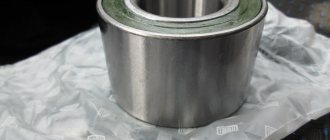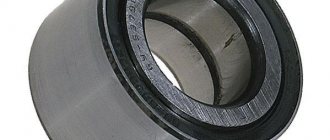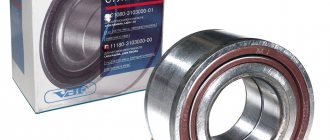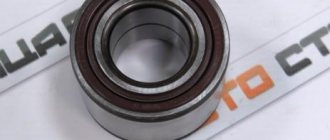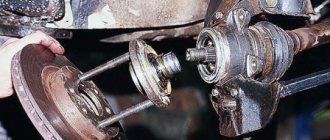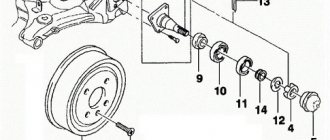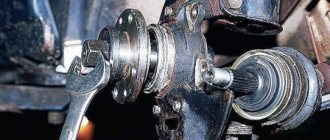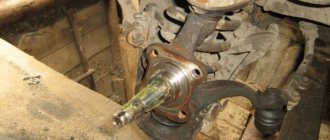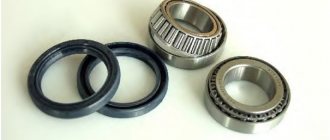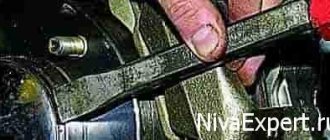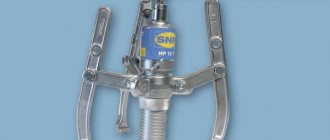Car rear wheel bearings are a type of bearing support that ensures the rotation of the rear wheel of a car and its rigid fixation on the axle. The bearing itself is located in the hub, to which the wheel is in turn attached. Bearings differ in design, size, and technical characteristics.
In this article we will consider the following questions:
- Methods for replacing rear wheel bearings;
- Causes and symptoms of malfunction;
- Types of wheel bearing units, numbers and sizes;
- Tips for use and replacement.
To begin with, we present 2 typical layouts of parts. In the diagram on the left is a non-separable hub assembly with HUB-3 (3rd generation bearing) - on the right is HUB-1 (1st generation).
Hub functions
The main part of the car chassis assembly that experiences the heaviest loads is the hub, both front and rear. Because it is an intermediate part connecting the wheels and suspension of the car. If this important part breaks down, there is a threat to all road users. Each wheel has its own hub. The wheel is rigidly attached to the hub and performs a rotational movement around its axis, and the hub is attached rigidly to the car’s suspension. Depending on what kind of drive the car has, the functions of the hub differ. If the car has rear driving wheels, then the rear wheel hubs perform an additional function - this is the redistribution of torque from the crankshaft to the wheel. It turns out that the rear hub of such cars is an element of the transmission, and not just the chassis. The following parts are attached to the wheel hub - brake discs or drums. Inexpensive machines have drums installed. Therefore, another function of the rear wheel hub is to provide braking. In addition, the hub serves as a location for installing various sensors (speed, ABS, control and other technical indicators) that modern cars are equipped with. These are the functions of the rear hub:
- Ensuring rigid, reliable fixation of the wheel to the suspension.
- Ensuring the wheel rotates around its axis.
- Maintains anti-lock braking and braking systems.
- Serves as a mounting location for various sensors.
Tips for maintenance and operation of bearings
- How to lubricate a wheel bearing.
- Keep dust away from grease and bearings. Lubrication of external surfaces prevents corrosion. For external lubrication, perform the following operations:
- First, you need to cleanly rinse the seat of the clip with kerosene, wipe it dry, then lubricate the seating surface with a thin layer of lubricant. Put on a clean rubber glove, apply lubricant to your palm and rub it into the bearing, then insert the part inside and additionally wipe the surface with a rag moistened with lubricant.
- You can use any anti-corrosion lubricant; specialized lubricants for bearing units are sold on the market. When applying, observe the amount of lubricant - there should be no leaks from the unit.
- Lubrication of the bearing inside is possible if it is open or has rubber seals. Add lubricant inside, but here you also need to follow an important rule - there should be no excess lubricant (turn the races repeatedly, excess lubricant will come out, it should be removed).
Recommended lubricant is presented in the table:
| Lubricant brands | Manufacturers | Thickener | Base oil |
| RareMax AF-1 | Kyodo Yushi Co., Ltd. | Urea | Mineral oil |
| 6459 Grease N | Showa Shell Sekiyu, KK | Urea | Mineral oil |
| Pyronoc Universal N-6C | Nisseki Mitsubishi Oil Corporation | Urea | Mineral oil |
| HB-1 | Kyodo Yushi Co., Ltd. | Urea | Mineral oil |
| Ronex MP | Exxon/Mobil | Lithium | Mineral oil |
- How to extend service life.
Tighten the axle nut to the recommended torque. Excessive tension will cause excess friction, the lubricant will heat up, dry out, and the rubbing parts will become deformed. Insufficient fastening torque will cause more play than is permissible, which will lead to premature wear. Use original spare parts (nut, cotter pin, retaining ring, etc.) to repair bearings.
Calculate service life "Wheel Bearing Life Calculator"
Read the article “Tightening torque of wheel bearings”
- Which wheel bearing to choose based on manufacturer, and what to look for when purchasing.
The original number is indicated on the case; the manufacturer recommends installing it. If it is not possible to get the original, there are replacement brands. The main thing is that the dimensions and technical characteristics match. On the packaging, look at the inscriptions, barcode, stamped number on the case, and the package contents.
Read the article “Rating of the best wheel bearing manufacturers”
- Wheel bearing kit - what it includes.
The repair kit includes consumable parts: wheel nuts 1 or 2 pcs., wheel bolts - set, lock ring 2 pcs. cotter pin Possible oil seals, outer races and even lubricant.
- What to use a press or puller.
For high-quality work, use a press, remove the assembly, take it to a service station, and for a small fee they will replace the assembly parts in 1-1.5 hours. The puller is used when replacing independently, purchased or rented. An assistant's hand will be useful for holding the key.
Important point:
Do not put pressure on the inner race of the bearing, as this may damage the elements of the bearing assembly.
- ABS bearings.
The presence of an impulse ring can be easily checked by placing a metal object on one side of the seals. The magnetized side is placed inside the hole of the fist to the connector of the reading sensor.
Rear hub device
The design of the rear hubs differs depending on whether the vehicle is front-wheel drive or rear-wheel drive. The hub is a round metal piece with an outer rim that has many small holes and one large internal hole.
The outer rim with holes is needed to attach the wheel. Guide bolts and studs are screwed into the holes to secure the wheel axle. Wheels are usually mounted with either 4 or 5 bolts, but there are also up to 8 bolts. The inner hole of the hub is designed to fit onto the bearing. The CV joint is installed in the hole in it. Some hubs have multiple locations for electronic sensors for ABS, speed, etc. All hubs are secured with two bolts and one washer. The hub is seated through the bearing onto the axle. The axle is also a very important part in the chassis of a car. Roller or cone bearings are used.
Spare part selection
To replace the rear wheel bearing, you will need not only the bearing itself, but also the wheel nut. At least that's what the car manufacturer requires. When going to a car shop or market to buy a new wheel bearing, it doesn’t hurt to be aware of which spare parts are suitable for your car and which manufacturers you can trust.
The table below shows proven brands indicating the catalog numbers of bearings for the rear hub of the VAZ-2114 produced by them.
| LADA | 21083104020 |
| LEMFOERDER | 2006801 |
| SKF | VKBA 559 |
| ZKL | 2108-3104020 |
| TRISCAN | 853070201 |
| ABS | 200068 |
| SPIDAN | 26727 |
| SNR | R17204 |
| Mastersport | 2108-3104020 |
| MEYLE | 2146330001 |
| SCT GERMANY | SCP 1307 |
| SBS | 1401762312 |
| AUTOKIT | 1,28 |
| OPTIMAL | 802658 |
| FLENNOR | FR891547 |
| N.K. | 762312 |
| MOOG | LA-WB-11604 |
| M.G.A. | KR3106 |
| IPD | 309110 |
| LONGHO | 8751615 |
| FIAT | 4178737 |
| Marketoem | 2108-3104020 |
| LSA | 21083104020 |
| FEBEST | DAC30600037 |
| FINWHALE | HB321 |
| FIRST LINE | FBK468 |
| Kemp | 77644281 |
| KAWE | FR891547 |
| CORTECO | 19017731 |
| BREDA LORETT | CR 2552 |
| BORG & BECK | BWK468 |
| Complex | CX 081 |
| CORAM | CR001 |
| Euroex | 2108-3104020 |
Rear wheel hub failure
Serious breakdowns can be avoided by timely diagnostics and, if signs of malfunction are detected, prompt elimination.
What breaks hubs:
- A sporty driving style, that is, with jerks, drifting, turning at high speeds, as well as fast driving over bumps.
- Overload of a vehicle.
- Getting stuck in mud and snow when the car sat on its bottom.
During such operation of the car, the hub housing may crack and the bearing may jam.
Headlight adjustment
To correctly adjust the headlights of a VAZ-2110 car, the instructions recommend contacting a service station equipped with a special stand or mobile device for adjusting the direction and quality of the light flux. The device shows not only the direction of light, but also the quality of light distribution of the reflector and glass diffuser, which allows us to judge the suitability of the headlight for further use. Experiments have shown that within 4-5 years of operation, all elements of the headlight become unusable and are unable to create the correct direction and the required level of illumination and must be replaced.
Symptoms of a problem
Options for self-diagnosis:
- When cornering, it is especially audible if the wheel bearing begins to fail.
- Push the rubber of the wheel crosswise with your foot to determine if there is any play. If there is play (free play), then it’s time to change the hub.
- If there is a hum in the wheel area. In this case, you need to lift the car with a jack and check the wheel for play. In this case, sounds of crunching and creaking are possible. When such a hum appears, you can no longer operate the car, because the hub or bearing has already worn out to the maximum and the wheel can jam at any moment.
When changing a wheel, you should also check the hub. If it is replaced, you must ensure that the thread does not break when tightening the rear wheel hub bolt.
Bottom line
After removing the car from the stands and jack, you can try it out while driving. Enjoyment of silence and satisfaction from the work done will be ensured. And most importantly, now you have confidence in the reliability and safety of your car.
The wheel bearing, brake drum and wheel disk provide forward motion, braking, and control of the vehicle's wheels, ensuring the safety of the driver and passengers. Replacing the VAZ 2109 hub is quite possible with your own hands if you have all the necessary materials and tools at your disposal.
The time standards for replacing the hub, according to the technical data for the VAZ 2109, are 27 minutes with the wheel removed. These instructions with photos will help you change the rear hub.
Rear hub replacement tools
To dismantle the hub you will need the following tools:
- Set of socket heads with extension.
- Pliers (pliers) for removing the locking ring.
- A spanner wrench for unscrewing the brake drum guide pins.
- A block of wood to prevent metal from hitting metal.
- Percussion instrument (hammer, cleaver, half sledgehammer).
- Mount.
- Chisel.
How to replace the hub:
- Loosen the wheel nuts.
- Raise the car with a jack. Place supports for belaying. Place anti-recoil devices (shoes).
- Remove the decorative cap (center of the wheel).
- Unscrew the wheel nuts.
- Remove the brake drum from the hub or remove the disc brake caliper.
- Unscrew the bolts securing the hub to the bracket. The bolt is unscrewed through a special hole in the hub itself. To gain access, you need to rotate the flange until the holes line up with the bolts. These nuts are tightened with a large torque, so unscrewing them is not so easy.
- Unscrew the caliper mounting bolts, steering knuckle mounting bolts and brake pad guides.
- Pull out the hub. The rear hub is removed from the bearing. You need a special puller to press the hub off the bearing.
Diagnostic procedure
Self-checking of the wheel bearing is carried out in the following order. You should alternately jack up the left and right sides of the vehicle and spin the wheels.
Having found a wheel that makes a hum when rotating, you should rock it in different directions. As a rule, backlash is quickly detected. In some cases, this is caused by a loose hub nut. To eliminate this possibility, it should be tightened using a torque wrench and locked. If the play and extraneous noise have not disappeared, the wheel bearing should be replaced.
Since the VAZ-2110 has been out of production for quite some time, it cannot be under warranty. This car is not equipped with overly complex electronics, unlike many foreign cars. Therefore, if you have the necessary tools and some skills, you can replace the wheel bearing on the “ten” yourself.
How to determine when an element is time to change?
The main signs of a wheel bearing malfunction are a metallic hum and/or wheel play while driving. The last criterion is difficult to notice on your own. A video taken from a car behind you may help.
In order for the driver to determine where the fault is located, it is necessary to turn sharply at speeds of up to 15 km/h. If the noise disappears, the element on the opposite side has broken. To check, it is recommended to make a similar turn in the other direction.
When grinding and crunching noises are heard, the driver is advised to stop. This is a sign of complete failure of the bearing, which may result in the wheel flying off.
In stationary conditions, the malfunction is determined after the vehicle is placed on a lift. Deviations on the drive axles are checked by accelerating to 70 km/h and listening to the hum near each of the wheels. If the wheel is not driving, it is turned by hand and rocked. The play will be felt.

